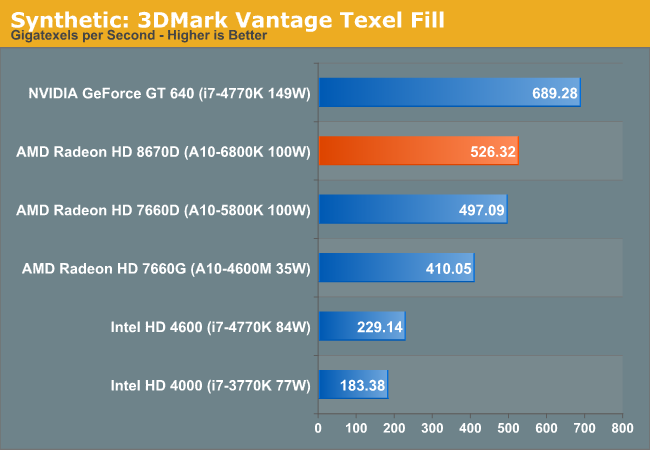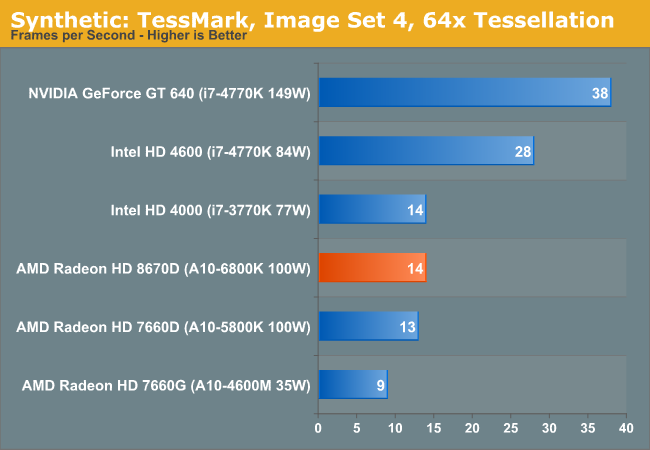AMD's Richland vs. Intel's Haswell GPU on the Desktop: Radeon HD 8670D vs. Intel HD 4600
by Anand Lal Shimpi on June 6, 2013 12:00 PM ESTSynthetics
Our synthetic benchmarks can sometimes tell us a lot about what an architecture is capable of. We'll turn to 3DMark Vantage first to stress ROP and texel rates.

Moving on, we have our 3DMark Vantage texture fillrate test, which does for texels and texture mapping units what the previous test does for ROPs.

Haswell could use some extra texture hardware, here Richland delivers more than 2x the peak textured fill rate of Haswell GT2.
Finally we’ll take a quick look at tessellation performance with TessMark.

As we saw in our Iris Pro review, Hawell's tessellation performance is surprisingly good.










102 Comments
View All Comments
BSMonitor - Thursday, June 6, 2013 - link
No, the comparison is absolutely meaningless. You are saying that someone's decision to buy a Core i7 4770 is influenced by the iGPU. It is not.Ortanon - Thursday, June 6, 2013 - link
The comparison isn't for people buying Core i7 lol. You wouldn't need a comparison if you were already going to buy it. The comparison is exactly what it says: Radeon HD 8670D vs. Intel HD 4600.BSMonitor - Thursday, June 6, 2013 - link
That's what I said. He is saying the price between the two should also matter. And as you say, people buying a Core i7 are not comparing iGPUs.BSMonitor - Thursday, June 6, 2013 - link
The comparison in question is not the article... It's the price comparison, go back to the beginning of the thread.silverblue - Thursday, June 6, 2013 - link
Unless you're very much interested in QuickSync, that is.jjj - Thursday, June 6, 2013 - link
1080p monitors can be found even bellow 100$ ,there isn't really a point in reviewing desktop anything bellow 1080p. going lower to find where a game becomes playeble is fine but the review should have 1080p tests even if the products are not good enough.Would be nice if Kaveri would double the SP count but AMD might be going for a smaller die to cut costs given their difficult financial situation. Wouldn't quite match the Xbox in perf but would be close enough and could do a decent job at playing console ports for the next few years.
DigitalFreak - Thursday, June 6, 2013 - link
Why test at a resolution where you're not going to get playable frame rates? If you can only get playable frame rates @ 768p by running medium quality, I'm pretty sure it's going to be unplayable at anything other than low / minimum @ 1080p.jjj - Thursday, June 6, 2013 - link
that's one of the points ,"you are pretty sure" not sure because the review doesn't do it's job to show you for sure and if you want a clear picture you need to look elsewhere.Death666Angel - Thursday, June 6, 2013 - link
Considering that nothing here is playable at 900p, it is quite possible to extrapolate that 1080p won't be playable either. So I'm pretty fine with them not testing it. If you get a $150 APU to play the latest games at 1080p (a resolution much larger than current consoles support in gaming, might I add), you are deluded.britjh22 - Thursday, June 6, 2013 - link
Are the tests currently set up to show higher res but lower detail settings? I know there is a set benchmark settings that they use to normalize, which is fine for high end CPU/mid to high end GPU testing. If I remember correctly the setting, as they climb in "quality" (low, medium, high) increase both resolution and detail concurrently. With Trinity/Richland and eventually Kaveri, it would be interesting to see if these APU's can handle recent games at higher resolution, but lower detail settings. Essentially can you get any recent games to play at common resolutions, even if you have to crank down settings.